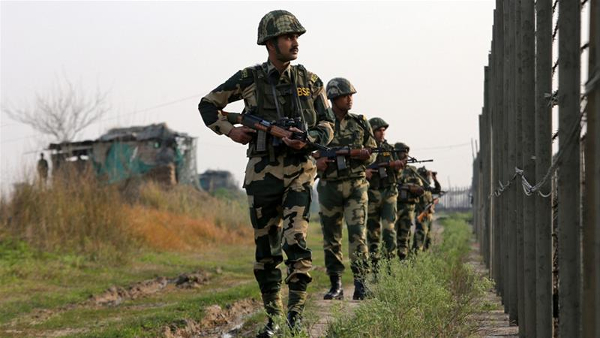With no encounter being reported at the Line of Control (LoC) between militants and security forces, police and security officials say there has been virtually no cross-border infiltration so far this year — a marked departure from previous years.
The Army usually tracks infiltrations through the number of face-offs at the LoC and this year, there has been none. The J&K Police, on the other hand, uses ground intelligence to find out new faces from across the border. Police say there has been a “significant drop” in infiltrations.
While Jammu & Kashmir Governor Satya Pal Malik has already pronounced “zero inflitration” this year, security forces, though in broad agreement with Malik, are sligthly more circumspect. “It is too premature to say that cross-border infiltration has ceased completely but definitely there has been a significant drop this year,” a senior police officer told The Sunday Express.
“By this time last year, around 15 militants had been killed while trying to infiltrate into Kashmir. But as of now, there has been no report of an encounter between militants and security forces on the border,” he said.
Police sources say that this year, only one encounter took place in the border area. On June 22, a Jaish-e-Mohammad (JeM) militant was killed in a gunfight at Boniyar in Uri.
“Our information says the killed militant was already active in the Valley,” said a police officer. “He was either trying to exfiltrate back to Pakistan or was there to receive a new militant group. But he was eliminated before he could do anything.”
The figures are in contrast with the infiltration figures for the corresponding period last year. Speaking in Parliament, then Minister of State for Home Hansraj Ahir had said that militants made 133 infiltration attempts in the first six months of 2018. From January to June last year, 14 militants and one security force personnel had been killed on the border during encounters between the infiltrating militants and security forces.
Security officials say there could be a number of reasons for the decline: the post-Pulwama, post-Balakot international pressure on Pakistan; the scrutiny of the Financial Action Task Force; Pakistan’s need to project Prime Minister Imran Khan’s offer of talks with India as genuine; or, a temporary pause.
“This winter there was heavy snowfall in the Valley and traditional infiltration routes were closed, thus delaying the infiltration. But by now, the snow in many areas has already started to melt and there is still no significant movement of infiltrators,” said a senior officer. “It seems that the international pressure on Pakistan and the threat of FATF blacklisting is holding Pakistan back”.
Lt General Hooda (retd), who was Northern Army GOC-in-C from 2014-2016, said every year, the infiltration usually begins mid-May, when much of the snow has melted, in the window before the Army starts repairing portions of the LoC fence that collapse every year under snowfall.
“In the Army, we would call this (the absence of infiltration) an ‘early indicator’,” Lt Gen Hooda said, “pointing to some checks by the Pakistan Army on these fellows (militants). They have their own launch pads, but they do require permission from the Pakistan Army before they cross the border”.
While the decline in infiltration and cross-border terrorism may be good news tactically, security agencies have also warned against “triumphalism”, and are even advocating some swift confidence-building measures at this time, such as reaching out to members of Kashmir’s civil society, engaging with the youth, improving governance, strengthening pro-India stakeholders, even reaching out to Pakistan to find out if its present “unsolicited co-operation” —- including intelligence tip-off of an imminent terror attack in the Valley earlier this month – is genuine outreach or just tactical.
The Sunday Express has learnt that security officials have redflagged the dangers of “destroying assets” in Kashmir, and highlighted the importance of taking the aggressive campaign launched by Central agencies against corruption in the Valley to Jammu as well.
The situation, sources said, continues to be volatile with home-grown radicalism still high, even though, besides the drop in infiltration, militant attacks in the Valley have also reduced after the Pulwama attack that brought India and Pakistan to the brink of conflict. Officials figures reveal that while 71 security forces personnel were killed so far this year, only 27 were killed after the Pulwama attack.
Most of the security forces personnel were killed during anti-militancy operations. “Though there have been grenade attacks here and there, after the Pulwama attack, militants carried out only two major attacks – a suicide attack in Anantnag and an IED blast at Pulwama,” said a police officer. “Only eight security force personnel have been killed in militant attacks since Pulwama and the rest in anti-militancy operations.”
The figures reveal that 120 militants and three of their associates were killed in the first six months of this year. Ninety-four of them were killed after forces intensified anti-militancy operations following the Pulwama attack in which 40 paramilitary personnel were killed.
Source: IE
Image Courtesy: Vocfm
You may also like
-
IAF Aircraft Set Course For Exercise Eastern Bridge VII At Oman
-
IAF Set To Host The Indian Defence Aviation Exposition-II At Jodhpur
-
Defence Secretary to co-chair 5th India-Philippines Joint Defence Cooperation Committee meeting in Manila
-
Simultaneous Launch Of ‘malpe And Mulki’, Fourth And Fifth Ships Of Asw Swc (Csl) Project
-
Aatmanirbharta in Defence: MoD signs Contract with HAL for 240 AL-31FP Aero Engines for Su-30MKI Aircraft
